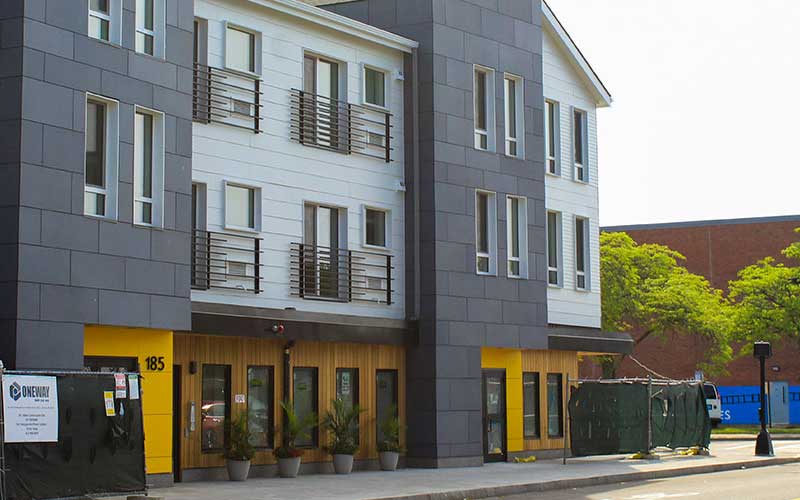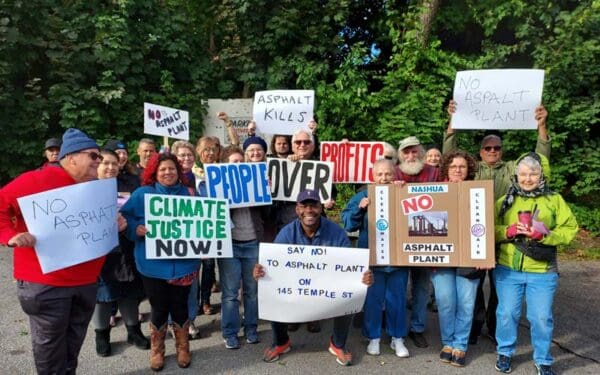
A view of the 191 Talbot Avenue development while under construction.
For many years, a gas station sat on the triangle of land at 191 Talbot Avenue in Boston’s Dorchester neighborhood. Cars pulled in and out daily to fill up on the fossil fuels driving our climate crisis. Following that, the parcel sat abandoned and vacant for nearly a decade.
Today, the slice of land at the corner of Talbot and Bernard Street exemplifies innovative, walkable development, cleaning up contaminated land and revitalizing the neighborhood. An energy-efficient, 14-unit apartment building opened to residents there in 2022. The apartments require very little energy to heat and cool, which keeps residents’ energy bills low. And the building is just a two-minute walk from an MBTA commuter rail station and bus stop. The apartments are reasonably priced, too, aimed explicitly at those who make too much to qualify for subsidized rents but who have been priced out of Boston’s expensive rental market. Another boon to neighborhood residents? The locally owned, woman-led Caribbean restaurant on the first floor specializing in healthy, locally grown foods.
It’s just one more success story for CLF’s Healthy Neighborhoods Equity Fund, which helped finance the development. The Fund, a partnership between CLF and the Massachusetts Housing Investment Corporation, celebrates a decade of progress in bringing new sources of capital to mixed-use, mixed-income, projects with positive environmental and social impacts.
Meeting Climate Goals through Smart Development
The transformation of Talbot Avenue is symbolic of the broader change we work for day in and day out at CLF. Transitioning our homes, businesses, and transportation systems from dirty fossil fuels to clean energy is essential to slashing climate-damaging emissions in New England – and it’s also part of our vision of supporting healthier, more livable, and more equitable neighborhoods across the region.
Achieving that vision requires us to use every tool in our toolbox, from law and policy to research and investment, to create long-term change. For example, not only was the Talbot Avenue apartment building financed partly with the help of the Healthy Neighborhoods Equity Fund, but Talbot Avenue’s Caribbean restaurant, Fresh Food Generation, was supported by CLF’s Legal Food Hub in 2019, which offered free legal assistance when the business was just getting started. And going back even further, the nearby MBTA station opened in 2012, expanding access to public transit in this low-income community because of CLF’s successful advocacy. Working with community-based organizations, CLF was able to expand transit to offset air pollution resulting from Boston’s Big Dig. All this work over two-plus decades has helped support the building of a vibrant, walkable neighborhood.
A New Vision for a Neighborhood
One of the most inspiring aspects of 191 Talbot Avenue is that it shows how climate-smart development can be done – and still be priced affordably for residents. The project re-uses vacant land for compact, walkable homes near public transit – precisely the development we envisioned when launching the Healthy Neighborhoods Equity Fund. Creating communities that get people out of cars and provide for daily needs close by is a big part of the solution for both climate and health.
Some of the essential features at 191 Talbot Avenue are not even visible. You can’t readily see the tight building envelope, but it makes all the difference in energy use. Every home has electric heat and cooling pumps, enabling residents to live without burning fossil fuels. Buildings like this one built to Passive House standards use 70% less energy for heating and cooling, lowering emissions and utility bills and improving tenant comfort.
And climate-smart construction exists alongside long-term affordability. Rents have soared higher than ever in the City of Boston, but at 191 Talbot Avenue, rents are about half of the average Boston studio price. Deed restrictions on these homes mean that rents will remain affordable for households for those earning below-average incomes (80% to 90% of average median income) over the next 15 to 30 years. Lower rents mean people have more money for other essential expenses, which is even more critical with today’s inflation.
Healthy Neighborhoods around Massachusetts
Talbot Avenue is one of nine sustainable housing developments in Massachusetts financed through the Healthy Neighborhoods Equity Fund. Others have been built in Chelsea, Beverly, and Brockton. Among those nine projects, 60% included remediation of formerly contaminated sites, 89% meet green building standards, and 33% include on-site renewable energy systems. On average, homes have been built just a stone’s throw from public transit, about 0.2 miles across all projects.
We are now looking to replicate that success in other New England states with the launch of more equity funds. What’s more, we hope that our work will serve as a model for a new kind of impact investment that can be replicated locally and nationally.
Our communities’ health, well-being, and economic success are tightly linked to the health and well-being of our environment, and vice versa. That’s why CLF takes a holistic approach when making investments with impact. We don’t just invest in affordable housing. We invest in climate-smart housing with low carbon emissions. We invest in housing in walkable communities near public transit, green space, and healthy food options. Every investment we make, and everything we advocate for, focuses on supporting a healthier, more prosperous, more sustainable future – for everyone.




